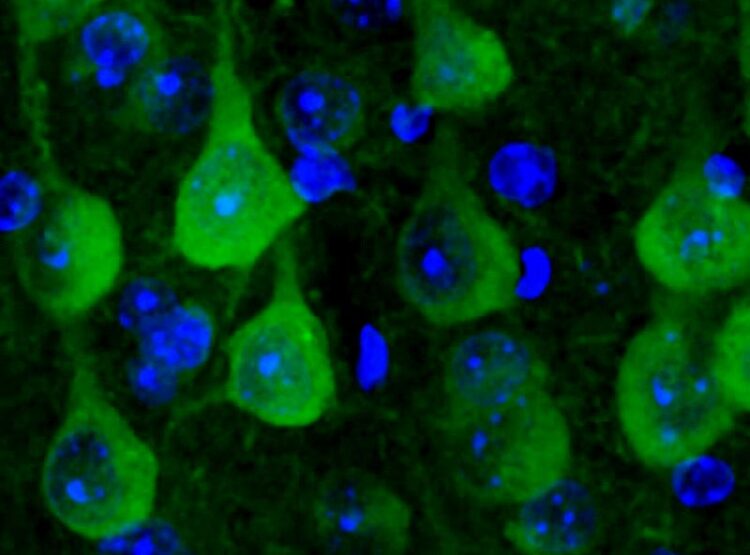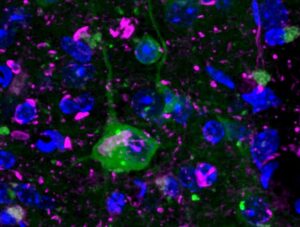Flawed quality control in the brain

In healthy mouse neurons, the proteostasis sensor (in green) distributes evenly.
© MPI of Neurobiology / Blumenstock
Proteins are only able to perform their essential tasks in the body if they fold correctly into their respective, very specific 3D structure. To ensure that nothing goes wrong with the folding process, it is strictly monitored in the cell. A flawed quality control can lead, for example, to the deposition of misfolded proteins in neurodegenerative diseases such as Alzheimer’s. Researchers at the Max Planck Institutes of Neurobiology and of Biochemistry have now developed a mouse line that makes the state of protein balance visible in the mammalian brain for the first time. In this way, the processes of protein quality control can now be studied in healthy and diseased neurons in more detail.
Proteins fulfill all important tasks in our body: They transport substances, protect against diseases, support the cell and catalyze chemical reactions – to name just a few. With the building instructions in our genetic code, every protein can be produced as a long chain of amino acids. However, that’s not the end of the story: in order to perform their vital functions, proteins have to fold into complex 3D structures.
Each cell contains a whole machinery that helps proteins to fold, corrects folding errors and discards misfolded proteins. As a kind of quality control, the system thus contributes to proteostasis – the controlled function of all proteins.

© MPI of Neurobiology / Blumenstock
In healthy cells, this quality control works very well. With age, however, it gradually deteriorates. This can become a problem, especially for nerve cells. These cells do not renew themselves and are therefore dependent on stable protein function throughout their lives. In fact, neurodegenerative diseases such as Alzheimer’s, Parkinson’s or Huntington’s disease have in common that certain misfolded proteins overload the quality control system and are not disposed of. These proteins accumulate, clump together and eventually form deposits in the brain tissue. Depending on the disease, this can lead to impaired memory or muscle control – with no chance of a cure so far. The ability to enhance the neurons’ quality control could thus present a promising therapeutic option.
In order to study the quality control defects in the individual diseases in more detail, scientists led by Irina Dudanova developed a new mouse line. With these animals, the state of proteostasis can be visualized in the mammalian brain for the first time.
The researchers introduced the protein that normally makes fireflies glow into the neurons of the mouse. Optimized to the body temperature of the beetle, the protein needs constant help to fold in “warmer” mammals. Only then can it adopt its correct structure and produce light. In order to precisely track the location of the luminescent protein in the cell, the scientists additionally labeled it with a dye. In this way, they showed that the protein is evenly distributed and glows in healthy neurons. However, if the protein quality control is overstrained, the beetle protein makes clumps and no longer glows as strongly. The beetle protein therefore serves as a proteostasis sensor.
The researchers then crossed the newly developed mouse line with mice that represent different neurodegenerative diseases. In mice showing signs of Alzheimer’s disease, the luminescent protein formed clumps, signaling strong proteostasis disturbance. Interestingly, this was not the case in Chorea Huntington mice. Irina Dudanova relates, “The different results were quite surprising. When we had a closer look at the possible reasons, we found that both the misfolded proteins themselves and their location in the cell play an important role.”
While the misfolded protein in the Alzheimer’s model forms deposits in the cell body, it clumps together in the cell nucleus in the Huntington’s mice. Accordingly, protein quality control and its capacity can vary greatly within a cell. “This shows how complex protein quality control is and how different its alterations can be in individual neurodegenerative diseases,” explains Irina Dudanova.
With the new mouse line, scientists now have a tool to specifically investigate this complexity – both in healthy and in diseased neurons. Irina Dudanova and her team plan to investigate other neurodegenerative diseases and to find out whether different cell types in the brain are affected at different rates. In addition, the mouse line could help to assess the effectiveness of different therapies for neurodegenerative diseases.
CONTACT
Dr. Christina Bielmeier
Public Relations
Max Planck Institute of Neurobiology, Martinsried
Phone: 089 8578 – 3601
E-mail: presse@neuro.mpg.de
Wissenschaftliche Ansprechpartner:
Dr. Irina Dudanova
Research Group Leader Molecular Neurodegeneration
Max Planck Institute of Neurobiology, Martinsried
Phone: +49 89 8578 – 3542
Email: idudanova@neuro.mpg.de
Originalpublikation:
Sonja Blumenstock*, Elena Katharina Schulz-Trieglaff*, Kerstin Voelkl, Anna-Lena Bolender,
Paul Lapios, Jana Lindner, Mark S. Hipp, F. Ulrich Hartl, Rüdiger Klein and Irina Dudanova
(*co-first)
Fluc-EGFP reporter mice reveal differential alterations of neuronal proteostasis in aging and disease
The EMBO Journal, online August 19th 2021
Weitere Informationen:
http://www.neuro.mpg.de/news/audio – Audio version of this press release
http://www.neuro.mpg.de/dudanova – Website of the Research Group “Molecular Neurodegeneration”
Media Contact
All latest news from the category: Life Sciences and Chemistry
Articles and reports from the Life Sciences and chemistry area deal with applied and basic research into modern biology, chemistry and human medicine.
Valuable information can be found on a range of life sciences fields including bacteriology, biochemistry, bionics, bioinformatics, biophysics, biotechnology, genetics, geobotany, human biology, marine biology, microbiology, molecular biology, cellular biology, zoology, bioinorganic chemistry, microchemistry and environmental chemistry.
Newest articles

A universal framework for spatial biology
SpatialData is a freely accessible tool to unify and integrate data from different omics technologies accounting for spatial information, which can provide holistic insights into health and disease. Biological processes…

How complex biological processes arise
A $20 million grant from the U.S. National Science Foundation (NSF) will support the establishment and operation of the National Synthesis Center for Emergence in the Molecular and Cellular Sciences (NCEMS) at…

Airborne single-photon lidar system achieves high-resolution 3D imaging
Compact, low-power system opens doors for photon-efficient drone and satellite-based environmental monitoring and mapping. Researchers have developed a compact and lightweight single-photon airborne lidar system that can acquire high-resolution 3D…





















